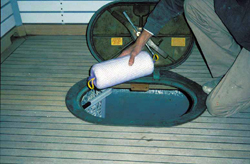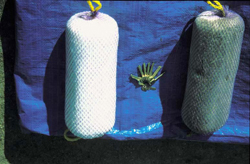New York Sea Grant's
Marina Pollution Prevention Web Site
Section 3: Hauling
and Storing Boats - Bilge
Cleaning
Potential Environmental Impacts
Bilge water
can commonly contain oil, fuel, antifreeze, and other contaminants.
Even small amounts of such materials introduced into the marina
environment can cause environmental problems, especially if they
persist. Although some oil that spills into the water evaporates,
petroleum hydrocarbons can remain suspended in the water column,
concentrate on the surface, or settle to the bottom. An oil sheen
can block necessary oxygen and light from moving through the surface
of the water. According to the EPA, the hydrocarbons in oil harm
juvenile fish, upset fish reproduction, and interfere with the
growth and reproduction of bottom-dwelling organisms.
Best
Management Practices
 Before
pumping out a bilge, visually inspect the bilge water to determine
whether there is a visible sheen of oil.
Before
pumping out a bilge, visually inspect the bilge water to determine
whether there is a visible sheen of oil.
Use oil absorbent
materials to remove oil before pumping a bilge.
Consider using
a portable or stationary oil/water separator to clean bilge
water (for examples, click
here). These devices draw contaminated water from
bilges, capture hydrocarbons in a filter and discharge clean water.
Don't use
soaps and detergents to clean up oily bilge water.
Educate customers
to keep their engines properly maintained, to continually check
and fix all leaks, and to keep  an
absorbent pad or pillow in the bilge to absorb small drips and
spills. For information on the performance of different types
of oil absorbent pads, click
here.
an
absorbent pad or pillow in the bilge to absorb small drips and
spills. For information on the performance of different types
of oil absorbent pads, click
here.
Regulatory
Issues
Oily bilge water or any petroleum product that is discharged to
the waters of the state must be reported to the state (In New
York call the NYSDEC Oil Spill Hotline at (800) 457 7362). For
more information on reporting and responding to spills in New
York, click
here.
If oily bilge water or any petroleum product that is discharged
into navigable waters causes a visible sheen, it may also be necessary
to report the discharge to the National Response Center at (800)
424-8802.
The use of dispersants, such as dishwashing soaps or detergents,
on a fuel spill or sheen of any size on the surface water is prohibited
in most circumstances [40 CFR 110.4, click
here]. Dispersants may only be used with permission
from federal or state authorities, and only in rare instances.
If oily bilge water cannot be sufficiently cleaned for legal discharge,
make arrangements with a waste hauler to properly dispose of the
bilge water.
If there is a stormwater discharge from your facility and any
oily bilge water may come into contact with precipitation you
may have to register for a General Permit for the Discharge of
Storm Water Associated with Industrial Activity ("Storm Water
General Permit"). For more information on storm water
permitting in New York, click
here.

